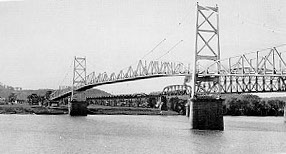Ohio River
Ohio River is a major river in the eastern United States, flowing southwesterly from western Pennsylvania through the Ohio Valley, and joining the Mississippi River at the point where the borders of Illinois, Kentucky, and Missouri converge. It is the largest tributary, by volume, of the Mississippi River. The Ohio River is 981 miles (1,579 kilometers) long and spans the width of the eastern United States, playing a crucial role in the commerce, ecology, and history of the region.
History[edit | edit source]
The name "Ohio" comes from the Seneca word ohiːyo, meaning "good river," "great river," or "large creek." Historically, the Ohio River was a significant natural boundary in the early United States and served as a major pathway for the movement of settlers and goods into the western territories. The river's valley has been inhabited by various indigenous cultures for thousands of years, with the Adena culture, Hopewell tradition, and Mississippian culture being among the most notable.
During the 18th century, the Ohio River became a contentious area during the French and Indian War and later, the American Revolutionary War, as both British and American forces sought to control the waterway. Following the Northwest Ordinance of 1787, the river served as a critical conduit for westward expansion.
Geography[edit | edit source]
The Ohio River begins at the confluence of the Allegheny River and the Monongahela River at Point State Park in Pittsburgh, Pennsylvania. It then flows northwest into Ohio, forming borders with the states of West Virginia, Kentucky, Indiana, and Illinois before joining the Mississippi River. The river's drainage basin covers parts of 14 states, making it one of the most expansive in the United States.
Major tributaries of the Ohio River include the Tennessee River, Cumberland River, Kanawha River, and the Wabash River. The river also features several large islands, such as Blennerhassett Island in West Virginia, which have their own unique histories and ecological significance.
Economy and Use[edit | edit source]
The Ohio River has been a vital artery for the transportation of goods and people since the time of early European settlement. It is heavily utilized for commercial navigation, with a system of locks and dams managed by the United States Army Corps of Engineers facilitating the movement of barges and other vessels. The river supports a variety of industries, including manufacturing, energy production, and agriculture.
In addition to its economic importance, the Ohio River is a source of drinking water for millions of people and offers numerous recreational opportunities, such as boating, fishing, and wildlife observation. However, the river has also faced environmental challenges, including pollution and habitat loss, prompting ongoing conservation efforts.
Environmental Concerns[edit | edit source]
The Ohio River has been subject to pollution from industrial waste, agricultural runoff, and sewage discharges, leading to concerns over water quality and ecosystem health. Efforts to clean and protect the river are ongoing, involving state and federal agencies, non-profit organizations, and local communities. These efforts include monitoring water quality, restoring habitats, and reducing pollution inputs.
Conclusion[edit | edit source]
The Ohio River is a significant natural resource and cultural landmark in the United States. Its waters have shaped the history, economy, and environment of the Ohio Valley and beyond. As efforts to preserve and protect the Ohio River continue, it remains a vital part of the nation's riverine landscape.
Search WikiMD
Ad.Tired of being Overweight? Try W8MD's physician weight loss program.
Semaglutide (Ozempic / Wegovy and Tirzepatide (Mounjaro / Zepbound) available.
Advertise on WikiMD
|
WikiMD's Wellness Encyclopedia |
| Let Food Be Thy Medicine Medicine Thy Food - Hippocrates |
Translate this page: - East Asian
中文,
日本,
한국어,
South Asian
हिन्दी,
தமிழ்,
తెలుగు,
Urdu,
ಕನ್ನಡ,
Southeast Asian
Indonesian,
Vietnamese,
Thai,
မြန်မာဘာသာ,
বাংলা
European
español,
Deutsch,
français,
Greek,
português do Brasil,
polski,
română,
русский,
Nederlands,
norsk,
svenska,
suomi,
Italian
Middle Eastern & African
عربى,
Turkish,
Persian,
Hebrew,
Afrikaans,
isiZulu,
Kiswahili,
Other
Bulgarian,
Hungarian,
Czech,
Swedish,
മലയാളം,
मराठी,
ਪੰਜਾਬੀ,
ગુજરાતી,
Portuguese,
Ukrainian
Medical Disclaimer: WikiMD is not a substitute for professional medical advice. The information on WikiMD is provided as an information resource only, may be incorrect, outdated or misleading, and is not to be used or relied on for any diagnostic or treatment purposes. Please consult your health care provider before making any healthcare decisions or for guidance about a specific medical condition. WikiMD expressly disclaims responsibility, and shall have no liability, for any damages, loss, injury, or liability whatsoever suffered as a result of your reliance on the information contained in this site. By visiting this site you agree to the foregoing terms and conditions, which may from time to time be changed or supplemented by WikiMD. If you do not agree to the foregoing terms and conditions, you should not enter or use this site. See full disclaimer.
Credits:Most images are courtesy of Wikimedia commons, and templates Wikipedia, licensed under CC BY SA or similar.
Contributors: Prab R. Tumpati, MD






